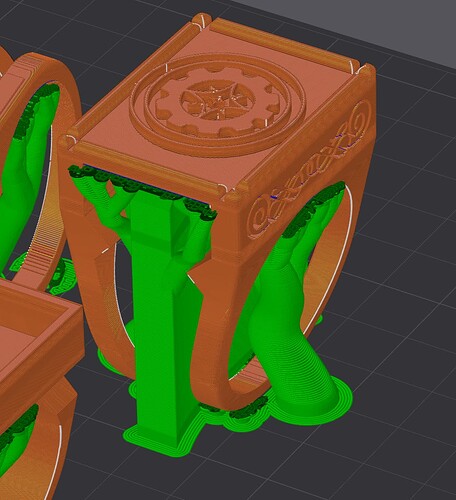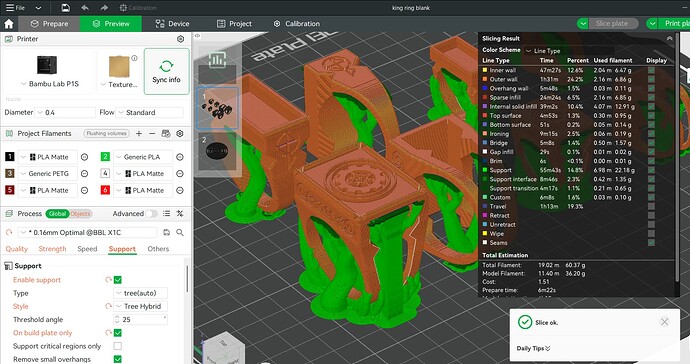Hi everyone, I have previously inquired about and searched for this feature, as I had some models with mixes of organic and flat, planar geometry which I felt would benefit from the use of mixed support generation types. As far as I had known, it was either something which could not be done, or which would require using a second model positioned within the geometry of 1st with opposite support typing and manual support enforcement/blocking, though I never tried the latter.
I appear to have accidentally gotten this behaviour in the pictured sliced model, though I am not sure how! As far as I can tell, it has no significant differences from an identical model oriented in the exact same way, but at 100% scale as opposed to the 150% scale pictured, which does not have this support generation. The ‘normal’ supports in the centre of the model appear to be replicable when recreating/reslicing the 3mf, though I haven’t tried on another machine. I’ll upload the 3mf here at the bottom of the post in case anyone would be able to confirm.
I wonder, is this just coincidence, and the supports only appear to be normal, or, is there a way to reliably force this mixed style of support generation on other models as selected by the user while slicing?
king ring blank.3mf (1.0 MB)
Tree Hybrid to repeat (tree (auto) seems to have selected that for you)
2 Likes
Thank you, this seems to be the answer, I thought I had selected hybrid when testing other support generation methods on this model to see if any would do this apart from auto, but clearly I missed it! I will have to take some more time to examine how Hybrid supports decide where these portions of normal supports are put in, as I have never seen this behaviour, but now that I know it’s so simple, I both feel very silly for not realizing and excited to get it working in my favor! I would love if support painting allowed for manually distributing the tree vs. normal support areas as we saw fit. I appreciate you taking a look and helping out!
1 Like
The hybrid nature of the support comes into play when there is sufficient need.
Small areas will still use tree support, and larger areas will become a calculated mix of tree and traditional ‘normal’ supports.
2 Likes
Indeed, though while it will often make the correct choice in some situations, I just often have overhangs which are large but not perfectly cantilevered flat, so it uses trees in those sections, despite the overhang being a very steep (5 degree) overhang (which I would prefer normal support for personally).
I’ve also, sadly, gotten a few ‘floating point exception’ crashes on some larger projects when I’m trying to slice 15+ plates simultaneously after swapping the models which could benefit from Hybrid to use it. Is this typical? I find Bambu Studio to be fairly stable and often run 4 or 5 instances with large multi-plate projects without fear of crashing or significant slowdown.
1 Like

